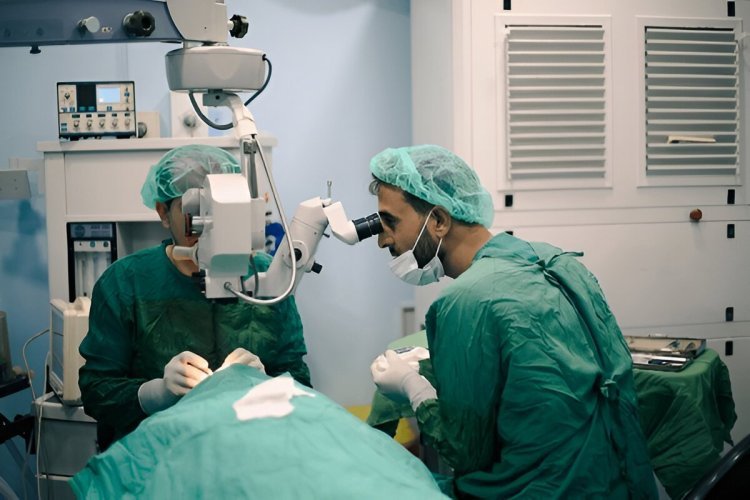Why Every Surgeon Needs a Surgical Microscope
Discover why a surgical microscope is essential for precision, accuracy, and better outcomes in every surgeon’s practice.

Surgery requires precision and accuracy. A surgical microscope helps doctors see tiny details clearly. It provides magnification, bright lighting, and a sharp view of tissues. This makes surgeries safer and more effective.
In this article, we will explore why every surgeon should use a surgical microscope. We will look at its benefits, uses, and how it improves patient care.
What Is a Surgical Microscope?
A surgical microscope is a special tool used in operating rooms. It helps doctors see small structures by making them look bigger. The microscope also provides bright light, so everything is clear.
Doctors use it for delicate procedures, like brain or eye surgery. Some models even have cameras to record surgeries for study and training.
Why Surgeons Need a Surgical Microscope
1. Helps Surgeons See Better
A surgical microscope gives a clear and enlarged view. It helps doctors see tiny nerves, blood vessels, and tissues. This reduces mistakes and improves precision.
2. Improves Lighting in Surgery
Good lighting is important for surgery. Shadows can make it hard to see small details. A surgical microscope provides bright and steady light. This makes the operation area clearer and safer.
3. Reduces Surgeon Fatigue
Performing surgery for long hours can be tiring. Without a microscope, doctors may have to bend over to see better. This can cause neck and back pain. A microscope allows them to sit comfortably while working.
4. Supports Minimally Invasive Surgery
Many modern surgeries use small cuts instead of large ones. A surgical microscope helps doctors work through tiny openings. This means less pain, faster healing, and lower infection risks for patients.
5. Leads to Better Patient Recovery
When doctors see better, they perform better. This means fewer mistakes, fewer complications, and faster recovery times. Surgical microscopes improve the overall success of operations.
Where Are Surgical Microscopes Used?
1. Brain and Spine Surgery (Neurosurgery)
Brain and spinal surgeries require extreme care. A microscope helps doctors see nerves and blood vessels clearly. This reduces the risk of damage and improves results.
2. Eye Surgery (Ophthalmology)
Eye surgeons need a clear and detailed view. A microscope helps in surgeries like cataract removal and corneal transplants. This improves accuracy and patient outcomes.
3. Dental and Root Canal Procedures
Dentists use microscopes to see deep inside teeth. This helps in root canals and gum treatments. A clear view ensures better cleaning and treatment of infections.
4. Plastic and Reconstructive Surgery
Plastic surgeons repair tiny blood vessels and nerves. A microscope helps in delicate surgeries, like facial reconstruction. It improves precision and success rates.
5. Ear, Nose, and Throat (ENT) Surgery
ENT doctors use microscopes for ear surgeries, such as cochlear implants. A magnified view helps them work safely in small areas.
6. Orthopedic and Spine Surgery
Spine surgeons need to avoid damaging nerves. A microscope helps them perform delicate procedures with greater accuracy. This reduces pain and speeds up recovery.
Features of Modern Surgical Microscopes
1. Digital Imaging and Video Recording
Many microscopes can record surgeries. This helps doctors review their work and train new surgeons.
2. 3D Vision for Better Depth Perception
Some microscopes provide a 3D view. This helps doctors see tissues and organs more clearly. It improves accuracy during surgery.
3. Autofocus and Stability
Modern microscopes have autofocus features. This keeps the image sharp without manual adjustments. Stable images help during long surgeries.
4. Works with Robotic Surgery
Some microscopes connect with robotic surgery systems. This allows for more precise movements and better control.
The Future of Surgical Microscopes
Technology is improving fast. Future microscopes may have:
- AI Assistance – Artificial intelligence may help doctors make better surgical decisions.
- Augmented Reality (AR) – Digital images may overlay the real view to provide extra guidance.
- Portable Designs – Smaller microscopes could be easier to use in different locations.
These changes will make surgeries even safer and more effective.
Conclusion
A surgical microscope is a must-have tool for every surgeon. It improves vision, reduces fatigue, and makes surgeries safer. From brain to dental procedures, this tool is essential in many fields.
As technology advances, surgical microscopes will become even more powerful. Investing in one means better surgery results and improved patient care.
What's Your Reaction?










